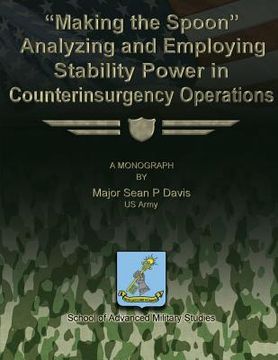"Making the Spoon": Analyzing and Employing Stability Power in Counterinsurgency Operations (in English)
Synopsis ""Making the Spoon": Analyzing and Employing Stability Power in Counterinsurgency Operations (in English)"
In the wake of operations in Iraq and Afghanistan, T.E. Lawrence's description of counterinsurgency (COIN) analogous to "eating soup with a knife," has new meaning in our contemporary military. It describes our kinetic conventional army (the knife) painstakingly operating in a nebulous environment (the soup), attempting to kill or capture terrorists. This monograph adapts the US military's sustainment and support capabilities to provide the military a counterinsurgency "spoon," through the theory of stability power. This thesis determines if the US Military's conduct of COIN operations requires the assignment of combat sustainment and support units as the main effort. In assigning these units this new decisive role, the military maximizes their intrinsic organizational advantages in nonkinetic stability operations. Such stability operations encompass what is decisive in defeating an insurgency. However, the design of current combat power analysis tools is not applicable for stability operations. The determination of a unit's capability in stability operations requires a new analysis model. Therefore, the military needs Relative Stability Power Analysis. Defining an organization's relative stability power is its ability to simultaneously represent all the elements of national power in proportion to the scale of the intervention, to stabilize a failing state. Assessing a unit's ability to do this is a hybrid model of systems theory, the military's logistical estimate model, and the relative combat power analysis tool. Military affairs experts require such a model to justify how many troops are required in the "clear" and "hold" phases and the requirements of the "build phase" in COIN operations. Placing these "build" requirements against the capabilities of the coalition determines operational shortfalls. Requirements-capabilities-shortfalls in Security, Water, Electricity, Academics, Transportation, Medical, and Sanitation (SWEAT-MS) describe Relative Stability Power Analysis. As the theory of stability power requires a new analytical model, it also requires a new concept of employment. A concept of employing stability power is a hybrid of subject matter on counterinsurgency, crisis response, and domestic policing. Testing this concept in a realistic scenario assists in evaluating its advantages and disadvantages. The scenario is a sustainment brigade (SUS BDE) operating as a Stability Reconstruction Sustainment Brigade (SRSB) securing the northern Iraqi city of Mosul in 2004. A commander that actually operated in this region during this time (COL H.R. McMaster, 3d Armor Cavalry Regiment) determines if it is feasible, acceptable, and suitable to employ sustainment units in this new capacity. This work concludes by submitting recommendations on how to employ stability power immediately, in the next few years and long term. Short-run recommendations include implementing attributes of stability power under Brigade Combat Team (BCT) control. Such attributes as assigning forward support companies to Iraqi security forces, and building combat outpost or micro operating bases securing the deliverance of essential public goods. In the midterm, relieving BCTs with SRSBs allows for the full economy of force advantages in employing stability power. The major significance of instituting SRSBs is expanding the pool of available units from only BCTs to all brigades capable of fighting COIN. This facilitates the army's ability to maximize the inherent advantages of all its forces. In the long-term, much as the US Army Air Corps became the US Air Force, this Stability and Reconstruction Forces (SRF) splits from the Army into a separate service. A SRF corps advances the US national capacity to conduct stability and reconstruction operations. In all, this vision of a force with balanced combat and stability power may prove the only acceptable alternative to meet the immediate emergency and security requirements of a failing state.

